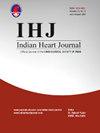Analysis of risk factors of low cardiac output syndrome after pericardiectomy for tuberculous constrictive pericarditis: A retrospective study
IF 1.8
Q3 CARDIAC & CARDIOVASCULAR SYSTEMS
引用次数: 0
Abstract
Objective
Low cardiac output syndrome (LCOS) is the leading cause of death after cardiac surgery. Studies have shown that 24% of postoperative mortality in patients undergoing pericardiectomy is attributed to LCOS. It is necessary to explore the risk factors of LCOS after pericardiectomy in patients with tuberculous constrictive pericarditis (CP).
Methods
Patients undergoing pericardiectomy for tuberculous CP were included in the study. The personal and clinical data of these patients with LCOS and without LCOS were collected and compared. Logistic regression analyses were conducted to identify the risk factors of postoperative LCOS. ROC curve analysis was used to check the accuracy of each risk factor to predict LCOS.
Results
A total of 175 patients with tuberculous CP were included in this study, of which 35 cases developed LCOS postoperatively, resulting in an incidence rate of 20%. The independent predictors of LCOS were preoperative NYHA class III/IV, decreased left ventricular mass index (LVMI), and hypoalbuminemia in these patients (p < 0.05). When albumin (ALB) < 30.35 g/L, it had the highest diagnostic value in predicting postoperative LCOS, with sensitivity and specificity of 59.4% and 86.9%, respectively (p < 0.01).
Conclusions
For patients with tuberculous CP, preoperative NYHA class III/IV, lower LVMI, and hypoalbuminemia are independent risk factors for LCOS following pericardiectomy. Clinically, these risk factors should be identified as early as possible, and early pericardiectomy should be performed when the patient's cardiac function remains well-preserved to avoid the occurrence of cardiac cachexia, myocardial atrophy and severe hepatic insufficiency.
结核性缩窄性心包炎心包切除术后低心输出量综合征危险因素分析:一项回顾性研究。
目的:低心输出量综合征(LCOS)是心脏手术后死亡的主要原因。研究表明,24%的心包切除术患者术后死亡率归因于LCOS。探讨结核性缩窄性心包炎(CP)患者心包切除术后发生LCOS的危险因素是有必要的。方法:对行结核性心包切除术的患者进行研究。收集并比较LCOS患者与非LCOS患者的个人及临床资料。通过Logistic回归分析确定术后LCOS的危险因素。采用ROC曲线分析检验各危险因素预测LCOS的准确性。结果:本研究共纳入175例结核性CP患者,其中35例术后发生LCOS,发生率为20%。LCOS的独立预测因子为术前NYHA III/IV级、左室质量指数(LVMI)降低、低白蛋白血症(p < 0.05)。白蛋白(ALB) < 30.35 g/L时预测术后LCOS的诊断价值最高,敏感性为59.4%,特异性为86.9% (p < 0.01)。结论:对于结核性CP患者,术前NYHA III/IV级、低LVMI和低白蛋白血症是心包切除术后LCOS的独立危险因素。临床上应尽早发现这些危险因素,在患者心功能保持良好的情况下尽早行心包切除术,避免发生心脏恶病质、心肌萎缩和严重肝功能不全。
本文章由计算机程序翻译,如有差异,请以英文原文为准。
求助全文
约1分钟内获得全文
求助全文
来源期刊

Indian heart journal
CARDIAC & CARDIOVASCULAR SYSTEMS-
CiteScore
2.60
自引率
6.70%
发文量
82
审稿时长
52 days
期刊介绍:
Indian Heart Journal (IHJ) is the official peer-reviewed open access journal of Cardiological Society of India and accepts articles for publication from across the globe. The journal aims to promote high quality research and serve as a platform for dissemination of scientific information in cardiology with particular focus on South Asia. The journal aims to publish cutting edge research in the field of clinical as well as non-clinical cardiology - including cardiovascular medicine and surgery. Some of the topics covered are Heart Failure, Coronary Artery Disease, Hypertension, Interventional Cardiology, Cardiac Surgery, Valvular Heart Disease, Pulmonary Hypertension and Infective Endocarditis. IHJ open access invites original research articles, research briefs, perspective, case reports, case vignette, cardiovascular images, cardiovascular graphics, research letters, correspondence, reader forum, and interesting photographs, for publication. IHJ open access also publishes theme-based special issues and abstracts of papers presented at the annual conference of the Cardiological Society of India.
 求助内容:
求助内容: 应助结果提醒方式:
应助结果提醒方式:


